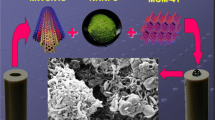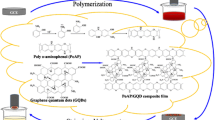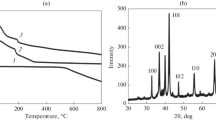Abstract
A novel platform for electroanalysis of isoniazid based on graphene-functionalized multi-walled carbon nanotube as support for iron phthalocyanine (FePc/f-MWCNT) has been developed. The FePc/f-MWCNT composite has been dropped on glassy carbon forming FePc/f-MWCNT/GC electrode, which is sensible for isoniazid, decreasing substantially its oxidation potential to +200 mV vs Ag/AgCl. Electrochemical and electroanalytical properties of the FePc/f-MWCNT/GC-modified electrode were investigated by cyclic voltammetry, electrochemical impedance spectroscopy, scanning electrochemical microscopy, and amperometry. The sensor presents better performance in 0.1 mol L−1 phosphate buffer at pH 7.4. Under optimized conditions, a linear response range from 5 to 476 μmol L−1 was obtained with a limit of detection and sensitivity of 0.56 μmol L−1 and 0.023 μA L μmol−1, respectively. The relative standard deviation for 10 determinations of 100 μmol L−1 isoniazid was 2.5%. The sensor was successfully applied for isoniazid selective determination in simulated body fluids.








Similar content being viewed by others
References
Escurra CM, Boogaard JVD, Jdema DI, Boeree M, Aarnoutse R (2012) Therapeutic drug monitoring in the treatment of tuberculosis patients. Pulm Pharmacol Ther 25:83–86
Kim HJ, Seo KA, Kim HM, Jeong ES, Ghim JL, Lee SH, Lee YM, Kim DH, Shin JG (2015) Simple and accurate quantitative analysis of 20 anti-tuberculosis drugs in human plasma using liquid chromatography-electrospray ionization-tandem mass spectrometry. J Pharmaceut Biomed 102:9–16
Li G, Zheng X (2007) Highly sensitive electrogenerated chemiluminescence isoniazid with NiO nanoparticles-modified graphite electrode. Anal Lett 40:1853–1863
Jena BK, Raj CR (2010) Au nanoparticle decorated silicate network for the amperometric sensing of isoniazid. Talanta 80:1653–1656
Peloquin CA (1997) Using therapeutic drug monitoring to dose the antimycobacterial drugs. Clin Chest Med 18:79–87
Chellini PR, Lages EB, Franco PHC, Nogueira FHA, César IC, Pianetti GA (2015) Development and validation of HPLC method for simultaneous determination of rifampicin, isoniazid, pyrazinamide, and ethambutol hydrochloride in pharmaceutical formulations. J AOAC Int 98:1234–1239
Swamy N, Basavaiah K, Vinay B (2015) Titrimetric assay of isoniazid with perchloric acid in nonaqueous medium. J Anal Chem 70:696–699
Abolhasani J, Hassanzadeh J (2014) Potassium permanganate–acridine yellow chemiluminescence system for the determination of fluvoxamine, isoniazid and ceftriaxone. Luminescence 29:1053–1058
Stets S, Tavares TM, Zamora PGP, Pessoa CA, Nagata N (2013) Simultaneous determination of rifampicin and isoniazid in urine and pharmaceutical formulations by multivariate visible spectrophotometry. J Braz Chem Soc 24:1198–1205
Zargar B, Hatamie A (2013) Localized surface plasmon resonance of gold nanoparticles as colorimetric probes for determination of isoniazid in pharmacological formulation. Spectrochim Acta A 106:185–189
de Assis JV, Teixeira MG, Soares CGP, Lopes JF, Carvalho GSL, Lourenço MCS, de Almeida MV, de Almeida WB, Fernandes SA (2012) Experimental and theoretical NMR determination of isoniazid and sodium p-sulfonatocalix [n] arenes inclusion complexes. Eur J Pharm Sci 47:539–548
Wu B, Wang Z, Xue Z, Zhou X, Du J, Liu X, Lu X (2012) A novel molecularly imprinted electrochemiluminescence sensor for isoniazid detection. Analyst 137:3644–3652
Liu Y, Fu Z, Wang L (2011) Capillary electrophoresis analysis of isoniazid using luminol-periodate potassium chemiluminescence system. Luminescence 26:397–402
Safavi A, Bagheri M (2008) Design of an optical sensor for indirect determination of isoniazid. Spectrochim Acta A 70:735–739
Lapa RAS, Lima JLFC, Santos JLM (2000) Fluorimetric determination of isoniazid by oxidation with cerium (IV) in a multicommutated flow system. Anal Chim Acta 419:17–23
Zamora LL, Mateo JVG, Calatayud JM (1992) Entrapment of reagents in polymeric materials. Indirect atomic absorption spectrometric determination of isoniazid by oxidation with manganese dioxide incorporated in polyester resin beads in a flow-injection system. Anal Chim Acta 265:81–86
Absalan G, Akhond M, Soleimani M, Ershadifar H (2016) Efficient electrocatalytic oxidation and determination of isoniazid on carbon ionic liquid electrode modified with electrodeposited palladium nanoparticles. J Electroanal Chem 761:1–7
Duarte JC, Luz RCS, Damos FS, de Oliveira AB, Kubota LT (2007) Tetracyanoquinodimethanide adsorbed on a silica gel modified with titanium oxide for electrocatalytic oxidation of hydrazine. J Solid State Electrochem 11:631–638
Rastogi PK, Ganesan V, Azad UP (2016) Electrochemical determination of nanomolar levels of isoniazid in pharmaceutical formulation using silver nanoparticles decorated copolymer. Electrochim Acta 188:818–824
Wu B, Hou L, Zhang T, Han Y, Kong Y (2015) A molecularly imprinted electrochemical sensor based on a gold nanoparticle/carbon nanotube hybrid material for the sensitive detection of isoniazid. Anal Methods 7:9121–9129
Zhu X, J XU, Duan X, L L, Zhang K, Y Y, Xing H, Gao Y, Dong L, Sun H, Yang T (2015) Controlled synthesis of partially reduced graphene oxide: enhance electrochemical determination of isoniazid with high sensitivity and stability. J Electroanal Chem 757:183–191
Quintino MSM, Angnes L (2006) Fast BIA-amperometric determination of isoniazid in tablets. J Pharmaceut Biomed 42:400–404
Yan X, Bo X, Guo L (2011) Electrochemical behaviors and determination of isoniazid at ordered mesoporous carbon modified electrode. Sens Actuat B-Chem 155:837–842
Martins PR, Ferreira LMC, Araki K, Angnes L (2014) Influence of cobalt content on nanostructured alpha-phase-nickel hydroxide modified electrodes for electrocatalytic oxidation of isoniazid. Sens Actuat B-Chem 192:601–606
Cheemalapati S, Chen SM, Ali MA, Hemaid FMA (2014) Enhanced electrocatalytic oxidation of isoniazid at electrochemically modified rhodium electrode for biological and pharmaceutical analysis. Colloid Surface B 121:444–450
Yang G, Wang C, Zhang R, Wang C, Qu Q, Hu H (2008) Poly(amidosulfonic acid) modified glassy carbon electrode for determination of isoniazid in pharmaceuticals. Bioelectrochemistry 73:37–42
Satyanarayana M, Reddy KK (2014) Gobi KV (2014) multiwall carbon nanotube ensembled biopolymer electrode for selective determination of isoniazid in vitro. Anal Methods 6:3772–3778
Azad UP, Prajapati N, Ganesan V (2015) Selective determination of isoniazid using bentonite clay modified electrodes. Bioelectrochemistry 101:120–125
Holloway AF, Wildgoose GG, Compton RG, Shao L, Green MLH (2008) The influence of edge-plane defects and oxygen-containing surface groups on the voltammetry of acid-treated, annealed and “super-annealed” multiwalled carbon nanotubes. J Solid State Electrochem 12:1337–1348
Báez DF, Bollo S (2016) A comparative study of electrochemical performances of carbon nanomaterial-modified electrodes for DNA detection. Nanotubes or graphene? J Solid State Electrochem 20:1059–1064
Gaonan L, Tongtong L, Ying D, Yong C, Fan S, Wei S, Zhenfan S (2013) Electrodeposited nanogold decorated graphene modified carbon ionic liquid electrode for the electrochemical myoglobin biosensor. J Solid State Electrochem 17:2333–2340
Prasannakumar S, Manjunatha R, Nethravathi C, Suresh SG, Rajamathi M, Venkatesha TV (2012) Graphene-carbon nanotubes modified graphite electrode for the determination of nicotinamide adenine dinucleotide and fabrication of alcohol biosensor. J Solid State Electrochem 16:3189–3199
Lu D, Lin S, Wang L, Li T, Wang C, Zhang Y (2014) Sensitive detection of luteolin based on poly (diallyldimethylammonium chloride)-functionalized graphene-carbon nanotubes hybrid/β-cyclodextrin composite film. J Solid State Electrochem 18:269–278
Yang H, Li Y, Liu Y, Zhang Y, Zhao Y, Zhao M (2015) One-pot chemical blasting synthesis of the bamboo-like multiwalled carbon nanotubes/graphene oxide nanocomposite and its application in electrochemical detection of dopamine. J Solid State Electrochem 19:145–152
Zanin H, Rosa CMR, Eliaz N, May PW, Marciano FR, Lobo AO (2015) Assisted deposition of nano-hydroxyapatite onto exfoliated carbon nanotube oxide scaffolds. Nanoscale 7:10218–10232
Zanin H, Ferreira AM, da Silva NS, Marciano FR, Corat EJ, Lobo AO (2014) Graphene and carbon nanotube composite enabling a new prospective treatment for trichomoniasis disease. Mat Sci Eng C-Bio S 41:65–69
Song Z, Lu J, Zhao T (2001) Chemiluminescence sensor for isoniazid with controlled-reagent-release technology. Talanta 53:1171–1177
Botta AC, Mollica FB, Ribeiro CF, de Araújo MAM, de Nicoló RD, Balducci I (2010) Influence of topical acidulated phosphate fluoride on surface roughness of human enamel and different restorative materials. Rev Odonto Ciênc 225:83–87
Liu L, Qiu CL, Chen Q, Zhang SM (2006) Corrosion behavior of Zr-based bulk metallic glasses in different artificial body fluids. J Alloy Comp 425:268–273
Zhang H, Wu L, Li Q, Du X (2008) Determination of isoniazid among pharmaceutical samples and the patients’ saliva samples by using potassium ferricyanide as spectroscopic probe reagent. Anal Chim Acta 628:67–72
Eidus L, Harnanansingh AMT (1971) A more sensitive spectrophotometric method for determination of isoniazid in serumor plasma. Clinical Chem 17:492–494
Hebié S, Bayo-Bangoura M, Bayo K, Servat K, Morais C, Napporn TW, Kokoh KB (2016) Electrocatalytic activity of carbon-supported metallophthalocyanine catalysts toward oxygen reduction reaction in alkaline solution. J Solid State Electrochem 20:931–942
Linares C, Geraldo D, Paez M, Zagal JH (2003) Non-linear correlations between formal potential and Hammett parameters of substituted iron phthalocyanines and catalytic activity for the electro-oxidation of hydrazine. J Solid State Electrochem 7:626–631
Nemes Á, Inzelt G (2014) Electrochemical and nanogravimetric studies of iron phthalocyanine microparticles immobilized on gold in acidic and neutral media. J Solid State Electrochem 18:3327–3337
Si X, Jiang L, Wang X, Ding Y, Luo L (2015) Determination of isoniazid content via cysteic acid/graphene modified glassy carbon electrode. Anal Methods 7:793–798
Brownson DAC, Banks CE (2014) The handbook of graphene electrochemistry. Springer, London
Shumba M, Nyokong T (2016) Electrode modification using nanocomposites of boron or nitrogen doped graphene oxide and cobalt (II) tetra aminophenoxy phthalocyanine nanoparticles. Electrochim Acta 196:457–469
Zúñiga C, Tasca F, Calderon S, Farías D, Recio FJ, Zagal JH (2016) Reactivity indexes for the electrocatalytic oxidation of hydrogen peroxide promoted by several ligand-substituted and unsubstituted Co phthalocyanines adsorbed on graphite. J. Electroanal Chem 765:22–29
Laviron E (1979) General expression of the linear potential sweep voltammogram in the case of diffusionless electrochemical systems. J Electroanal Chem 101:19–28
Bard AJ, Mirkin MV, Unwin PR, Wipf DO (1992) Scanning electrochemical microscopy. 12. Theory and experiment of the feedback mode with finite heterogeneous electron-transfer kinetics and arbitrary substrate size. J Phys Chem 96:1861–1868
Andrieux CP, Savéant JM (1978) Heterogeneous (chemically modified electrodes, polymer electrodes) vs. homogeneous catalysis of electrochemical reactions. J Electroanal Chem 93:163–168
Brett CMA, Brett AMO (1994) Electrochemistry principles, methods, and applications. Oxford University Press, London
Sabzi RE (2005) Electrocatalytic oxidation of thiosulfate at glassy carbon electrode chemically modified with cobalt pentacyanonitrosylferrate. J Braz Chem Soc 16:1262–1268
Karimi MA, Mehrjardi AH, Ardakani MM, Ardakani RB, Mashhadizadeh MH, Sargazi S (2010) Study of electrocatalytic oxidation of isoniazid drug using alizarin red S as a mediator on the glassy carbon electrode. Int J Electrochem Sci 5:1634–1648
Analytical Methods Committee (1987) Recommendations for the definition, estimation and use of the detection limit. Analyst 112:199–204
Majidi MR, Jouyban A, Zeynali KA (2006) Voltammetric behavior and determination of isoniazid in pharmaceuticals by using overoxidized polypyrrole glassy carbon modified electrode. J. Electroanal Chem 589:32–37
Acknowledgements
The authors are grateful to Brazilian funding agencies FAPEMA (00738/2014, BM-01363/15, and 00753/14), CNPq (305865/2013-7, 401689/2015-8 and 305680/2015-3), and FAPESP (2014/02163-7) for financial support.
Author information
Authors and Affiliations
Corresponding author
Rights and permissions
About this article
Cite this article
Spindola, R.F., Zanin, H., Macena, C.S. et al. Evaluation of a novel composite based on functionalized multi-walled carbon nanotube and iron phthalocyanine for electroanalytical determination of isoniazid. J Solid State Electrochem 21, 1089–1099 (2017). https://doi.org/10.1007/s10008-016-3451-9
Received:
Revised:
Accepted:
Published:
Issue Date:
DOI: https://doi.org/10.1007/s10008-016-3451-9




